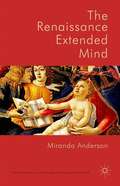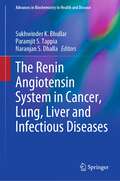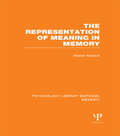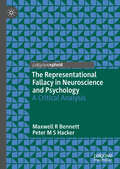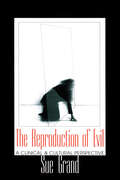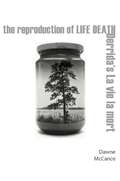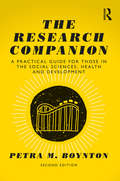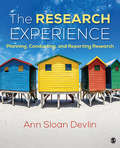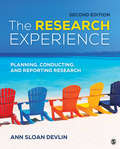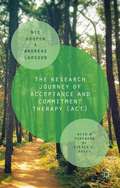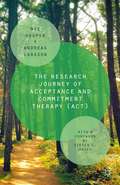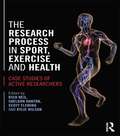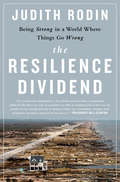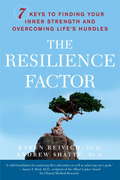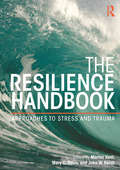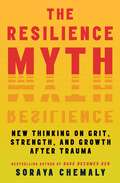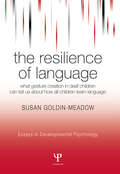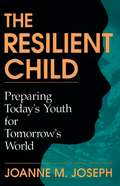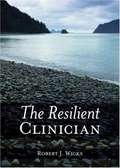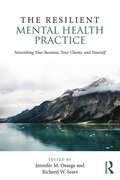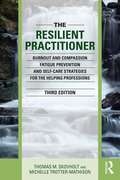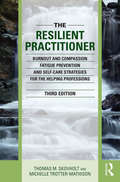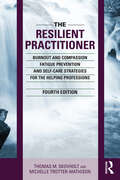- Table View
- List View
The Renaissance Extended Mind
by Miranda AndersonThe Renaissance Extended Mind explores the parallels and contrasts between current philosophical notions of the mind as extended across brain, body and world, and analogous notions in literary, philosophical and scientific texts circulating between the fifteenth century and early-seventeenth century. This perspective illuminates Renaissance texts and aims to inspire a more general reevaluation in the humanities of what constitutes cognition. Anderson begins with an overview of research and debates surrounding notions of the mind and subjectivity as extended in current cognitive scientific and philosophical research. This invites a reconsideration of other theories concerned with the relationship between brain, body and world, including psychoanalytical and literary theories. The book then explores Renaissance notions of the mind and subjectivity, in terms of the use of one's body, words, objects and other people as extensions ofthe mind and subject. It concludes by focusing on Shakespeare's literary and dramatic works. The Renaissance Extended Mind reveals the interdisciplinary potential and wider relevance of the notion of the extended mind: it establishes its capacity to contribute to a rethinking of the history of ideas and that it holds repercussions for literary methodologies, as well as offering a means to richer readings of literary texts.
The Renin Angiotensin System in Cancer, Lung, Liver and Infectious Diseases (Advances in Biochemistry in Health and Disease #25)
by Naranjan S. Dhalla Paramjit S. Tappia Sukhwinder K. BhullarThis book of the series on “Advances in Biochemistry in Health and Disease” includes state-of-the-art information on the status of renin-angiotensin system (RAS) in the form of 24 chapters. This book has been organized into three sections: (i) General Implications of RAS in human health and Infectious Diseases, (ii) Lung, Liver and Kidney Diseases, and (iii) Development of Cancer. Each chapter has discussed comprehensive knowledge regarding the molecular and cellular aspects of the role of RAS in the pathophysiology and pharmacotherapy of different disease processes. Biochemical mechanisms associated with angiotensin II type 1 and type II receptors, and angiotensin (1-7) MAS receptors for the occurrence of both harmful and beneficial effects of prolonged activation of RAS in different diseases have been outlined. It is noteworthy to point out that different chapter in this book were prepared by recognized global expertise in the area of inflammation, oxidative stress and signal transduction pathways to highlight the role of RAS in different diseases. It is our sincere hope that this book will be of great interest to both biomedical investigators and health professionals as well as graduate students and postdoctoral fellows all over the world.
The Representation of Meaning in Memory (Psychology Library Editions: Memory)
by Walter KintschOriginally published in 1974, this volume presents empirical and theoretical investigations of the role of meaning in psychological processes. A theory is proposed for the representation of the meaning of texts, employing ordered lists of propositions. The author explores the adequacy of this representation, with respect to the demands made upon such formulations by logicians and linguists. A sufficiently large number of problems are encompassed by the propositional theory to justify its use in psychological research into memory and language comprehension. A number of different experiments are reported on a wide variety of topics, and these test central portions of this theory, and any that purports to deal with how humans represent meaning. Among the topics discussed are the role of lexical decomposition in comprehension and memory, propositions as the units of recall, and the effects of the number of propositions in a text base upon reading rate and recall. New problems are explored, such as inferential processes during reading, differences in levels of memory for text, and retrieval speed for textual information. On the other hand, a study of retrieval from semantic memory focusses on a problem of much current research. The final review chapter relates the present work to other current research in the area at the time.
The Representational Fallacy in Neuroscience and Psychology: A Critical Analysis
by Maxwell R Bennett Peter M HackerThis book traces the history and coherence of the use of the word ‘representations’ from its origins, particularly in the description of artefacts, to its use in the description of so-called mental and neural representations in the mind and in the brain. It is shown that there are no good reasons for this transition. Experimental psychology is confused in taking what one perceives to be a mental representation. Neuroscientists need to avoid moving readily between the notions of neural and mental representations; indeed even the logic of taking a pattern of neural activity as standing for some sensibly experienced characteristic requires elucidation. It is concluded that the word ‘representation’ when used in experimental psychology and cognitive neuroscience is confounding.
The Reproduction of Evil: A Clinical and Cultural Perspective (Relational Perspectives Book Series #17)
by Sue GrandWhy is it that victims of abuse so often become perpetrators, and what can psychoanalysis offer to these survivor-perpetrators, whose criminal conduct seems to transcend the possibilities of empathic psychoanalytic inquiry. In The Reproduction of Evil, Sue Grand engages these deeply troublesome issues in the belief that psychoanalysts can and should reclaim the study of what lies beyond ordinary human empathy. Her goal is to elucidate the link between traumatic memory and the perpetration of evil. To this end, she presents an interdisciplinary analysis, at once scholarly and passionate, of the ways in which families and cultures transform victims of malignant trauma into perpetrators of these very traumas on others. Through intensive case studies, Grand draws the reader into the world of the survivor-perpetrators who commit acts of child abuse, of incest, of racial persecution, even of homicide and genocide. By infusing psychoanalytic inquiry with cultural analysis and by supplementing clinical vignettes with well-chosen literary illustrations, Grand is able to convey the survivor-perpetrator's immediacy of experience in a manner that readers may find unsettling, even uncanny. By interweaving psychoanalytic, sociohistorical, and literary perspectives, Grand fills a critical lacuna in the literature about trauma and its intergenerational transmission. Her analysis of the psychodynamic processes and cultural tensions that bind perpetrators, victims, and bystanders provides trenchant insights into the violence and fragmentation that beset our society. Essential reading for a wide clinical audience, The Reproduction of Evil will also be powerfully informative for academic and lay readers interested in the intrapsychic, interpersonal, and cultural factors that account for the perpetuation of evil from generation to generation.
The Reproduction of Life Death: Derrida's La vie la mort
by Dawne McCanceDuring the 1975–76 academic year, Jacques Derrida delivered a seminar, La vie la mort (Life Death), at the École normale supérieure, in Paris. Based on archival translations of this untapped but soon-to-be-published seminar, The Reproduction of Life Death offers an unprecedented study of Derrida’s engagement with molecular biology and genetics, particularly the work of the biologist François Jacob.Structured as an itinerary of “three rings,” each departing from and coming back to Nietzsche, Derrida’s seminar ties Jacob’s logocentric account of reproduction to the reproductive program of teaching that characterizes the academic institution, challenging this mode of teaching as auto-reproduction along with the concept of “academic freedom” on which it is based. McCance also brings Derrida’s critique of Jacob’s theory of auto-reproduction together with his reading of reproductivity, the tendency to repeat-reproduce, that is theorized and enacted in Freud’s Beyond the Pleasure Principle. The book further shows how Derrida’s account of life death relates to his writings on autobiography and the signature and to such later concerns as the question of the animal.McCance brings extensive archival research together with a deep knowledge of Derrida’s work a background in genetics to offer a fascinating new account of an encounter between philosophy and the hard sciences that will be of interest to theorists in a wide range of disciplines concerned with the question of life.
The Research Companion: A practical guide for those in the social sciences, health and development
by Petra M. BoyntonHave you ever wanted to know an effective and ethical way to: Design a study? Recruit participants? Report findings? And improve the quality and output of your research? The Research Companion focuses on the practical skills needed to complete research in the social or health sciences and development. It covers the behind-the-scenes essentials you need to run an effective and ethical piece of research and offers clear, honest advice to help avoid typical problems and improve standards and outcomes. It addresses each stage of the research process from thinking of a research idea, through to managing, monitoring, completing and reporting your project, and working effectively and safely with participants and colleagues. As well as covering theoretical issues in research, the book is full of links to other resources and contains practical tips and stories from researchers at all levels. This new edition is fully updated to reflect shifts in funding structures, open access, and online developments and has a link to a blog and friendly online community for readers to connect with diverse researchers all sharing experiences and offering practical advice. The Research Companion brings hard-earned lessons from the real world to offer invaluable guidance to all students of the social and health sciences, from those just beginning their first research project, to experienced researchers and practitioners. It will be instrumental in raising readers’ competence levels and making their research more accurate, ethical, and productive.
The Research Experience: Planning, Conducting, and Reporting Research
by Ann S. DevlinThe Research Experience: Planning, Conducting, and Reporting Research by Ann Sloan Devlin presents a process-oriented approach to research for students in the behavioral sciences. In-depth, practical advice for conducting each step of the research process includes coverage of the most common research methods and current technologies—including Qualtrics, Google Scholar, and Amazon Mechanical Turk—as well as techniques for finding participants and collecting data in a variety of settings. With robust pedagogy and six helpful appendices, this text will further readers’ ability to produce well-executed projects and critically evaluate information in both their personal and professional lives.
The Research Experience: Planning, Conducting, and Reporting Research
by Ann S. DevlinThe Research Experience: Planning, Conducting, and Reporting Research by Ann Sloan Devlin presents a process-oriented approach to research for students in the behavioral sciences. In-depth, practical advice for conducting each step of the research process includes coverage of the most common research methods and current technologies—including Qualtrics, Google Scholar, and Amazon Mechanical Turk—as well as techniques for finding participants and collecting data in a variety of settings. With robust pedagogy and six helpful appendices, this text will further readers’ ability to produce well-executed projects and critically evaluate information in both their personal and professional lives.
The Research Experience: Planning, Conducting, and Reporting Research
by Ann Sloan DevlinAnn Sloan Devlin&’s The Research Experience: Planning, Conducting and Reporting Research, Second Edition is the complete guide to the behavioral science research process. The book covers theoretical research foundations, guiding students through each step of a research project with practical instruction and help. The latest technological tools, such as SurveyMonkey®, Qualtrics®, and Amazon Mechanical Turk®, are included to show the increasing influence of the Internet to conduct studies and how research is conducted in the world today. Taking students through the process from generating ideas for research to writing and presenting findings helps them absorb and apply the material. With its practical emphasis and supporting pedagogy, students will be able to successfully design and execute a research project. New and Key Features Updated Ethics Chapter (Ch. 4) reflects revised Common Rule governing research with human subjects. This edition incorporates updates in the seventh edition of the APA Publication Manual, including Bias-Free Language and new citation and reference styles. Separate chapters on Correlational and Nonexperimental Research and Qualitative Research give more depth to these designs as important fields of study. Thorough coverage of research design and methods fundamentals emphasizes the practical issues involved in producing research projects and reports. Three types of questions throughout every chapter include Revisit and Respond, Try This Now, and Build Your Skills promote student learning.
The Research Experience: Planning, Conducting, and Reporting Research
by Ann Sloan DevlinAnn Sloan Devlin&’s The Research Experience: Planning, Conducting and Reporting Research, Second Edition is the complete guide to the behavioral science research process. The book covers theoretical research foundations, guiding students through each step of a research project with practical instruction and help. The latest technological tools, such as SurveyMonkey®, Qualtrics®, and Amazon Mechanical Turk®, are included to show the increasing influence of the Internet to conduct studies and how research is conducted in the world today. Taking students through the process from generating ideas for research to writing and presenting findings helps them absorb and apply the material. With its practical emphasis and supporting pedagogy, students will be able to successfully design and execute a research project. New and Key Features Updated Ethics Chapter (Ch. 4) reflects revised Common Rule governing research with human subjects. This edition incorporates updates in the seventh edition of the APA Publication Manual, including Bias-Free Language and new citation and reference styles. Separate chapters on Correlational and Nonexperimental Research and Qualitative Research give more depth to these designs as important fields of study. Thorough coverage of research design and methods fundamentals emphasizes the practical issues involved in producing research projects and reports. Three types of questions throughout every chapter include Revisit and Respond, Try This Now, and Build Your Skills promote student learning.
The Research Journey of Acceptance and Commitment Therapy (ACT)
by Nic Hooper Andreas LarssonIn 1986 the first research study investigating Acceptance and Commitment Therapy (ACT) was published. It aimed to determine if an early conceptualization of the ACT model could be used to treat depression. Since this seminal study, further investigations have been conducted across every imaginable psychological issue and the rate at which this research has emerged is impressive. This book describes the research journey that ACT has taken in the past 30 years. It also suggests, in light of the progress that has already been made, how ACT research should move forward in the coming decades.
The Research Journey of Acceptance and Commitment Therapy (ACT)
by Nic Hooper Andreas LarssonIn 1986 the first research study investigating Acceptance and Commitment Therapy (ACT) was published. It aimed to determine if an early conceptualization of the ACT model could be used to treat depression. Since this seminal study, further investigations have been conducted across every imaginable psychological issue and the rate at which this research has emerged is impressive. This book describes the research journey that ACT has taken in the past 30 years. It also suggests, in light of the progress that has already been made, how ACT research should move forward in the coming decades.
The Research Process in Sport, Exercise and Health: Case Studies of Active Researchers
by Sheldon Hanton Rich Neil Scott Fleming Kylie WilsonWhat are the challenges and potential pitfalls of real research? <P><P> What decision-making process is followed by successful researchers? <P><P> The Research Process in Sport, Exercise and Health fills an important gap in the research methods literature. Conventional research methods textbooks focus on theory and descriptions of hypothetical techniques, while the peer-reviewed research literature is mainly concerned with discussion of data and the significance of results. In this book, a team of successful researchers from across the full range of sub-disciplines in sport, exercise and health discuss real pieces of research, describing the processes they went through, the decisions that they made, the problems they encountered and the things they would have done differently. As a result, the book goes further than any other in bringing the research process to life, helping students identify potential issues and problems with their own research right at the beginning of the process.<P><P> The book covers the whole span of the research process, including: identifying the research problem justifying the research question choosing an appropriate method data collection and analysis identifying a study’s contribution to knowledge and/or applied practice disseminating results. <P><P> Featuring real-world studies from sport psychology, biomechanics, sports coaching, ethics in sport, sports marketing, health studies, sport sociology, performance analysis, and strength and conditioning, the book is an essential companion for research methods courses or dissertations on any sport or exercise degree programme.
The Resilience Dividend: Being Strong in a World Where Things Go Wrong
by Judith RodinBuilding resilience--the ability to bounce back more quickly and effectively--is an urgent social and economic issue. Our interconnected world is susceptible to sudden and dramatic shocks and stresses: a cyber-attack, a new strain of virus, a structural failure, a violent storm, a civil disturbance, an economic blow. Through an astonishing range of stories, Judith Rodin shows how people, organizations, businesses, communities, and cities have developed resilience in the face of otherwise catastrophic challenges: * Medellin, Colombia, was once the drug and murder capital of South America. Now it’s host to international conferences and an emerging vacation destination. * Tulsa, Oklahoma, cracked the code of rapid urban development in a floodplain. * Airbnb, Toyota, Ikea, Coca-Cola, and other companies have realized the value of reducing vulnerabilities and potential threats to customers, employees, and their bottom line. * In the Mau Forest of Kenya, bottom-up solutions are critical for dealing with climate change, environmental degradation, and displacement of locals. * Following Superstorm Sandy, the Rockaway Surf Club in New York played a vital role in distributing emergency supplies. As we grow more adept at managing disruption and more skilled at resilience-building, Rodin reveals how we are able to create and take advantage of new economic and social opportunities that offer us the capacity to recover after catastrophes and grow strong in times of relative calm.
The Resilience Factor: 7 Keys to Finding Your Inner Strength and Overcoming Life's Hurdles
by Karen Reivich Andrew ShatteResilience is a crucial ingredient-perhaps the crucial ingredient-to a happy, healthy life. More than anything else, it's what determines how high we rise above what threatens to wear us down, from battling an illness, to bolstering a marriage, to carrying on after a national crisis. Everyone needs resilience, and now two expert psychologists share seven proven techniques for enhancing our capacity to weather even the cruelest setbacks. The science in The Resilience Factor takes an extraordinary leap from the research introduced in the bestselling Learned Optimism a decade ago. Just as hundreds of thousands of people were transformed by "flexible optimism," readers of this book will flourish, thanks to their enhanced ability to overcome obstacles of any kind. Karen Reivich and Andrew Shatté are seasoned resilience coaches and, through practical methods and vivid anecdotes, they prove that resilience is not just an ability that we're born with and need to survive, but a skill that anyone can learn and improve in order to thrive. Readers will first complete the Resilience Questionnaire to determine their own innate levels of resilience. Then, the system at the heart of The Resilience Factor will teach them to:* Cast off harsh self-criticisms and negative self-images* Navigate through the fallout of any kind of crisis* Cope with grief and anxiety* Overcome obstacles in relationships, parenting, or on the job * Achieve greater physical health* Bolster optimism, take chances, and embrace life In light of the unprecedented challenges we've recently faced, there's never been a greater need to boost our resilience. Without resorting to feel-good pap or quick-fix clichés, The Resilience Factor is self-help at its best, destined to become a classic in the genre.From the Hardcover edition.
The Resilience Handbook: Approaches to Stress and Trauma
by John W. Reich Martha Kent Mary C. DavisHow are people and communities able to prevail despite challenge? What helps them bounce back from adversity and even grow in knowledge and understanding? And can this resilience be taught? During the past decade, exciting scientific advances have shed light on how resilience operates from neurons to neighborhoods. In The Resilience Handbook, experts in the science of resilience draw on human and animal research to describe the process of resilience and follow its course as it unfolds both within individuals and in social networks. Contributors also highlight the promise of new interventions that apply what we know about resilience processes to bolster positive health, and raise some of the pressing questions and issues for the field as it matures. This handbook is designed to be used by students as an invitation to a burgeoning field; by researchers, as a framework for advancing theories, hypotheses, and empirical tests of resilience functions; and by clinicians, as a comprehensive and up-to-the-minute integration of theory and practice.
The Resilience Myth: New Thinking on Grit, Strength, and Growth After Trauma
by Soraya ChemalyThe author of the &“must-read&” (NPR) Rage Becomes Her presents a powerful manifesto for communal resilience based on in-depth investigations into history, social science, and psychology.We are often urged to rely only on ourselves for strength, mental fortitude, and positivity. But with her distinctive &“skill, wit, and sharp insight&” (Laura Bates, author of Girl Up), Soraya Chemaly challenges us to adapt our thinking about how we survive in a world of sustained, overlapping crises. It is interdependence and nurturing relationships that truly sustain us, she argues. Based on comprehensive research and eye-opening examples from real-life, The Resilience Myth offers alternative visions of relational hardiness by emphasizing care for others and our environments above all.
The Resilience of Language: What Gesture Creation in Deaf Children Can Tell Us About How All Children Learn Language (Essays in Developmental Psychology)
by Susan Goldin-MeadowImagine a child who has never seen or heard any language at all. Would such a child be able to invent a language on her own? Despite what one might guess, the children described in this book make it clear that the answer to this question is 'yes'. The children are congenitally deaf and cannot learn the spoken language that surrounds them. In addition, they have not yet been exposed to sign language, either by their hearing parents or their oral schools. Nevertheless, the children use their hands to communicate - they gesture - and those gestures take on many of the forms and functions of language. The properties of language that we find in the deaf children's gestures are just those properties that do not need to be handed down from generation to generation, but can be reinvented by a child de novo - the resilient properties of language. This book suggests that all children, deaf or hearing, come to language-learning ready to develop precisely these language properties. In this way, studies of gesture creation in deaf children can show us the way that children themselves have a large hand in shaping how language is learned.
The Resilient Child: Preparing Today's Youth For Tomorrow's World
by Joanne A. JosephIf you try to identify the basic qualities of a child "most likely to succeed" as an adult, what words might first come to mind? Independent? Likable? Creative? Disciplined? According to Dr. Joanne Joseph, the essence of a productive and healthy personality is a positive and secure self-image and a solid set of resilient attitudes and behaviors. The Resilient Child: Preparing Today's Youth for Tomorrow's World successfully integrates the latest information available about healthy cognitive development, self-esteem, and resilience to give parents and teachers practical suggestions for nurturing these qualities in children and adolescents. Dr. Joseph, an esteemed psychologist and child education consultant, skillfully shows how stories, television, nutrition, exercise, parental discipline style, and the child's individual characteristics each play a comprehensive role in the development of a child's self-esteem and resilience. With the author's clearly outlined strategies, parents and educators can guide children to be socially skillful, responsible, disciplined, good problem-solvers, and effective managers of the change and adversity inherent in today's world. Elaborating beyond what others have identified as the elements of a productive personality, Dr. Joseph uses a series of inspiring anecdotes and documented research to discuss the following: what experts do and do not know about the development of self-esteem; how parents and teachers can actively contribute to the natural development of a child's self-esteem; how to promote resilience in children through happy and difficult times; the kinds of characteristics that differentiate children from each other; how to liberate a child's inner strengths to build self-esteem and resilience; how literature and the media can teach resilient and productive values and behaviors; styles of parental discipline and their influence on the development of the child; and more.
The Resilient Clinician
by Robert J. WicksThis immensely readable book also includes one of the most current selective bibliographies of relevant research and clinical and theoretical publications in the subject area, from common stressors and vicarious post-traumatic stress disorders to burnout and compassion fatigue.
The Resilient Mental Health Practice: Nourishing Your Business, Your Clients, and Yourself
by Richard W. Sears Jennifer M. OssegeThe Resilient Mental Health Practice: Nourishing Your Business, Your Clients, and Yourself is a fundamental resource for mental health professionals, designed to serve as a comprehensive yet parsimonious handbook to inspire and inform novice, developing, and experienced mental health professionals. Replete with case studies, The Resilient Mental Health Practice gives readers a big-picture view of private practice, including detailed explorations of various topics related to therapist self-care and preventing burnout. Chapters provide a range of ways in which clinicians can build a resilient and sustainable practice while also taking care of their clients and themselves.
The Resilient Practitioner (Third Edition): Burnout, Compassion Fatigue Prevention, And Self-care Strategies For The Helping Professions
by Thomas M. Skovholt Michelle J. Trotter-MathisonTherapists and other helping professionals work in highly demanding fields and can suffer from burnout, compassion fatigue, and secondary stress. The third edition of The Resilient Practitioner guides students and practitioners toward their own personal balance between caring for themselves and caring for others. This new edition includes a new chapter on models of resiliency, an updated self-care action plan, self-reflection exercises in each chapter, and other valuable additions, but readers will find that the new edition retains its strong grounding, focus on research, and accessible writing style. They'll also find that the new edition continues its focus on establishing working alliances and charting a hopeful path for practitioners, one that allows them to work intensely with human suffering and have a vibrant career in the process.
The Resilient Practitioner: Burnout and Compassion Fatigue Prevention and Self-Care Strategies for the Helping Professions (Counseling And Psychotherapy: Investigating Practice From Scientific, Historical, And Cultural Perspectives Ser.)
by Thomas M. Skovholt Michelle Trotter-MathisonThe Resilient Practitioner, 3rd edition, gives students and practitioners the tools they need to create their own personal balance between caring for themselves and caring for others. This new edition includes a new chapter on resiliency, an updated self-care action plan, self-reflection exercises in each chapter, and a revised resiliency inventory for practitioners. Readers will find, however, that the new edition keeps its strong focus on research and accessible writing style. The new edition also retains its focus on establishing working alliances and charting a hopeful path for practitioners, a path that allows them to work intensely with human suffering and also have a vibrant career in the process.
The Resilient Practitioner: Burnout and Compassion Fatigue Prevention and Self-Care Strategies for the Helping Professions, 4th ed
by Thomas M. Skovholt Michelle Trotter-MathisonThe Resilient Practitioner, 4th edition, gives students and practitioners valuable tools for creating their own boundaried generosity, a vibrant method for balancing caring for others and caring for oneself.The new edition builds on the strengths of the earlier editions and incorporates the lived experience of practitioners in the helping, caring, and relationship-intense fields. Readers will find new material in the Architecture of Resilience chapter, a self-care action plan that incorporates SMART goals to increase goal-setting success and a focus on both individual responsibility and organizational responsibility for burnout prevention and the development of resilience.The new edition also includes self-reflection exercises in each chapter, a resiliency inventory for practitioners, a strong focus on research, and an accessible writing style. The authors continue to chart a hopeful path for practitioners, one that allows for a high level of caring for others in the helping professions while also artfully caring for oneself.
